|
|
|
|
|
|
|
|
|
Gallery of craft examples and Custom Instruments
|
|
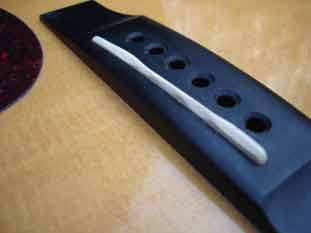 |
|
The picture at the left is an example showing that it is possible to shape and adjust an acoustic guitar bridge saddle for proper intonation compensation. The standard acoustic guitar saddle as a straight piece is inherently a poor compromise in tonality as one plays up the neck of the instrument. This is a painstaking procedure, but it will correct intonation to the discriminating ear. |
|
|
|
Quality fretwork is a specialty of Feldman Guitar Works. This is an example of a freshly done fret dress. The finish quality ensures that the frets will go a longer time before new grooves are worn into into the frets bringing the need for the next fret dress, or re-fretting. |
|
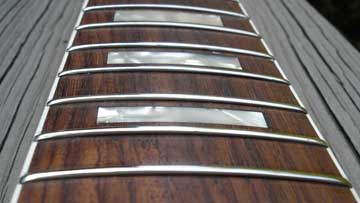 |
|
|
|
|
|
|
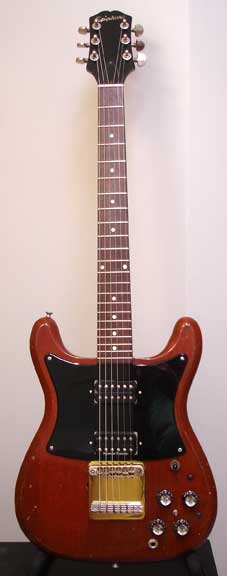 |
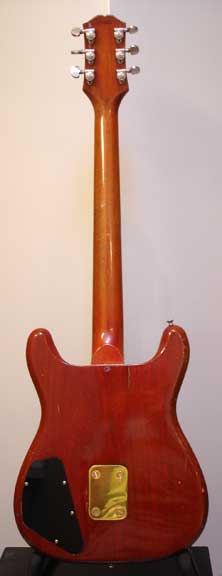 |
|
| The instrument pictured here is a custom 1962 Epiphone Wilshire solidbody with an interesting history, which includes having been in the hands of Jerry Garcia. |
|
|
|
|
|
Disclaimer notice: This instrument was originally modified at an innocent time in history when we had no concept of the future value of vintage instruments !
The original modifications included my "brass sandwich" block system which consists of a thick, polished brass block bolted to a brass plate, mounted flush, clamping the mahogany body, with the bridge and stop tailpiece mounted on the brass block....Rings like a bell! The guitar came back to me recently, as a complete "basket case" with a broken-off headstock, a patina of neglect and electronics dangling.
-Alan F.
|
|
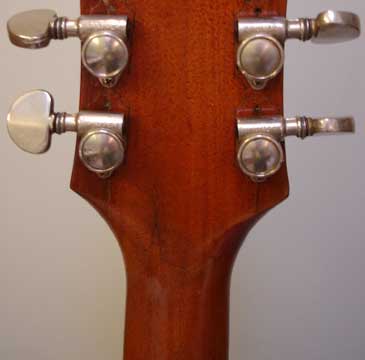 |
|
|
|
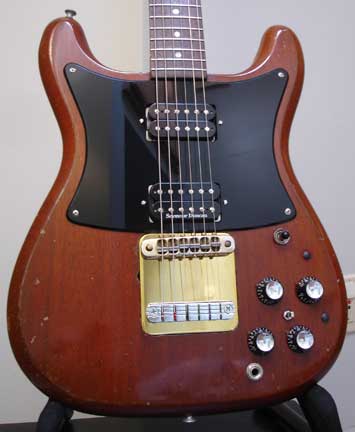 |
|
|
The "Blue Bass" is a custom mid-sixties Epihone Bass which came to me as a gutted (except for the pick-up) body and neck which looked rather like a piece of driftwood, as it had spent some time outdoors. The finish is a Kandy saphire blue laquer. A pair of dual-sound jazz bass pickups were added to mix with the original rich Gibson EBO pick-up. Each pick-up has a three way selector and a volume control. The EBO pick-up is wired to go out of phase. There is a master tone control mounted on a custom black plexiglass pickguard. |
|
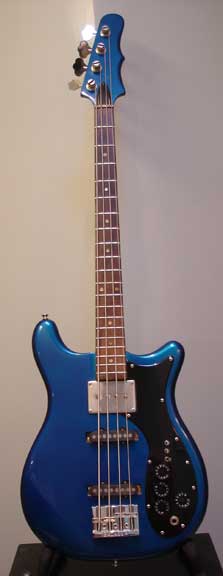 |
|
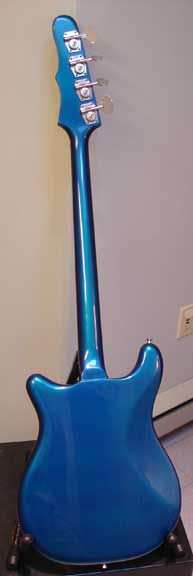 |
|
|
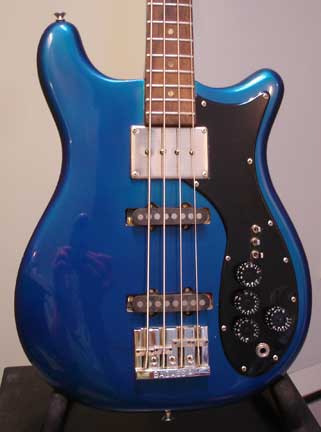 |
|
|
|
|
Here is an example of custom inlay work on a custom "made from scratch ebony fingerboard. The fingerboard is a replacement on an old Yamaha FG-300. It features more curvature (smaller radius) on the fingerboard itself, and the pearl inlays are the lotus symbols for six of the seven chakras or energy centers of the human body. A custom brass nut is also visible. |
|
|
 |
|
|
|
|
|
|
| The Green Strat is a custom that I built as a showpiece back in the eighties. It is an ash body with fifties style contours which is finished in "Irish Mist Pearlescent" acrylic laquer. The neck is a solid rosewood neck with a maple stripe and abalone inlays, cut just like a fifties neck with the fifties 7 1/2" radius. The neck was made by Phil Kubiki. the neck is finished with a thin coat of ntrocellulose laquer to promote the desired playing wear. The pickguard is custom made of white plexiglass. There are three vintage wind Seymour Duncan pickups, each with a three-way switch with on-off-out-of-phase operation, creating 12 different tones. There is a master volume control and a master tone control. All hardware is brass and gold.
|
|
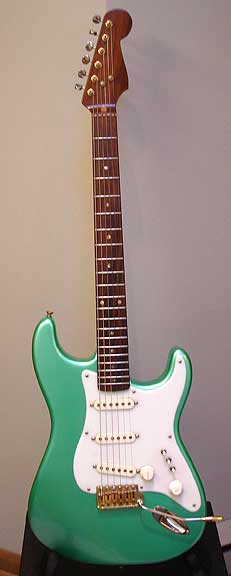 |
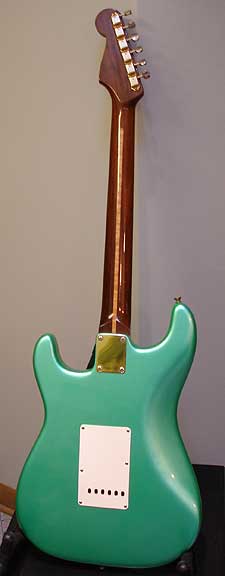 |
|
|
|
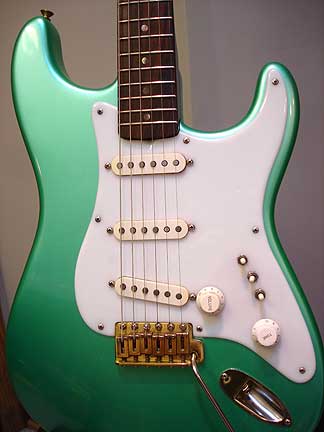 |
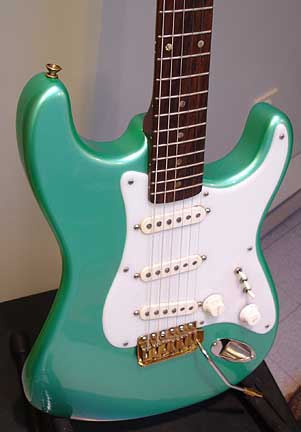 |
|
|
|
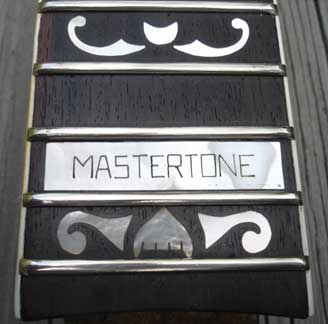 |
The picture at the left is a recent re-fret job on a classic Gibson Mastertone Banjo neck. The owner has another banjo with large fret-wire that he liked a lot, and requested a larger wire on this neck. This is a large medium guage wire. Another view is on the right. |
|
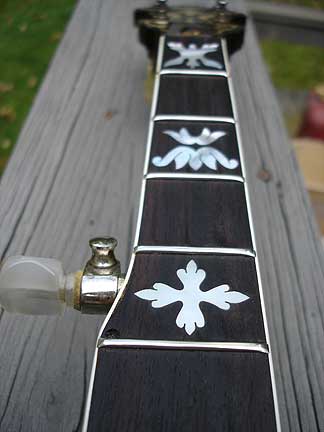 |
|
| Disclaimer notice: Once again this instrument was originally modified at a time in history when we had no concept of the future value of vintage instruments !
The instrument pictured here is from my personal collection, and I consider it my experimental guitar. It has been the subject of several "experiments" which I consider successful improvements. The Guitar is originally a 1965 left-handed Gretsch Duo-Jet which I purchased in a pawn shop in Cincinnati in 1970. I converted it to a right-hand guitar and played it for a number of years before adding the other modifications.
One thing that always bothered me about this particular instrument was the fact that the rather long expanse of the strings between the bridge and the original Burns vibrato tailpiece would ring sympathetically while the guitar was being played, but out of tune with the instrument! I replaced the tailpiece with a brass Stratocaster replacement vibrato bridge where I could use the secondary intonation adjustment to actually tune that sympathetic section of strings to the instrument. To further enhance this arrangement, I fashioned a bridge stand out of solid brass, bolted it to an internal brass plate that also has the adjustable Stratocaster tremolo spring claw fastened to it. This required some internal modifications to the instrument (which is hollow), and the addition of a Stratocaster type opening and back plate. The entire bridge/tailpiece arrangement recirculates with sustain! I fashioned a gold painted clear plexi cover to hide holes from the original Burns tailpiece and match the Gretsch plastic parts.
Electronically, I added an active tone control/boost system which is a parametric equallizer of sorts with low pass, high pass, band pass and notch filter functions, and a by-pass switch. There is also a phase switch on one of the pick-ups, which are the original Gretsch filter-trons. The batteries reside under the tremolo springs.
|
|
|
|
|
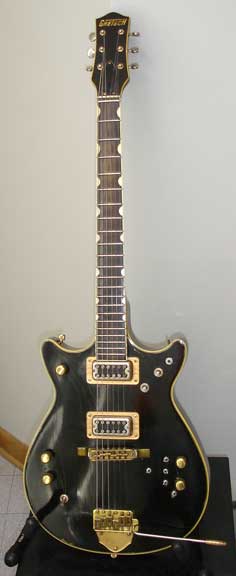 |
|
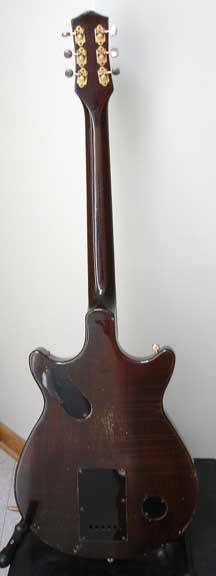 |
|
|
|
|
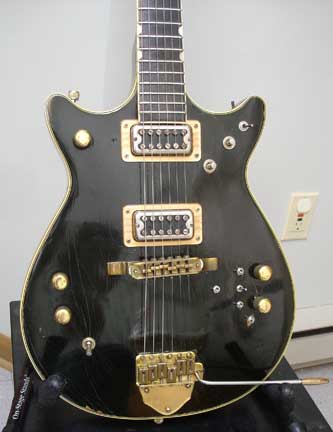 |
|
|
|
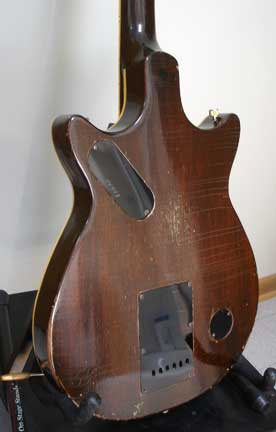 |
|
|
|
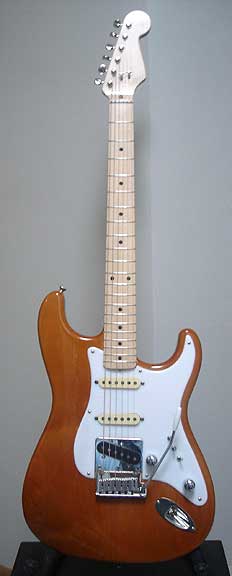 |
|
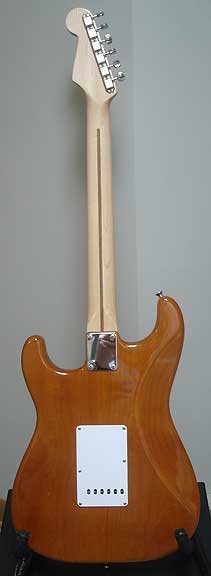 |
|
| This custom instrument is one of my latest creations, built to showcase my "Missing Link" bridge/pickup system. The Missing Link system combines the unique biting sound of a Telecaster® bridge pickup with an all metal link to a Strat® body and tremolo bridge system. The guitar has an Alder body and a vintage style maple neck finished in nitrocellulose lacquer. The guitar has a custom white plexiglass pickguard which carries Seymour Duncan "antiquity" pickups, each with a three way switch that offers "out-of-phase" and normal operation along with an off position. The bridge pick-up is a Duncan vintage Broadcaster pick-up with a corresponding on-off switch. There is a master volume and tone control with Tele® style dome knobs. This is a very resonant instrument that produces a variety of terrific tonal qualities!
Telecaster, Strat, and Tele are registered trademarks of Fender Musical Instruments, which is in no way affiliated with Feldman Guitar Works.
|
|
|
|
|
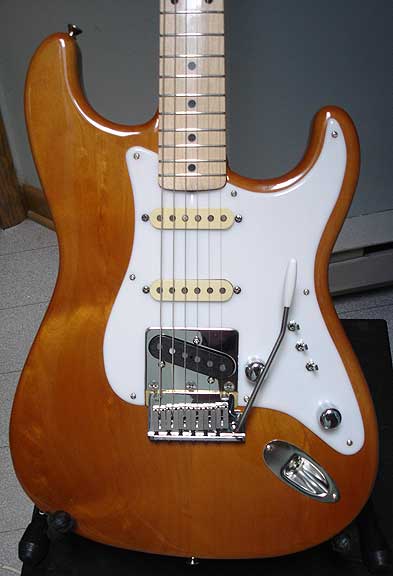 |
|
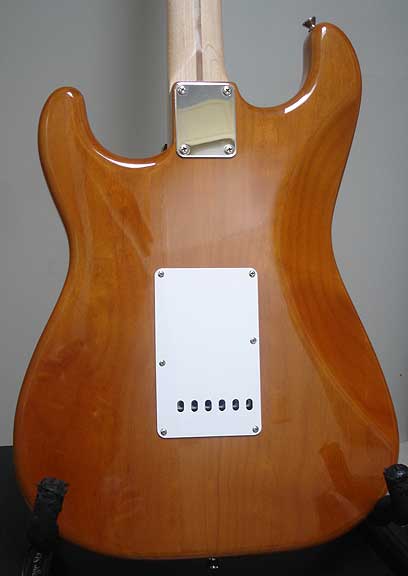 |
|
|
The instrument shown here is a retro-fit of the "Missing Link" bridge/pickup system in a Telecaster® application. In this case, the guitar retains all the Telecaster® qualities and biting sound, but gains the Stratocaster® vibrato unit. This is the only kind of vibrato that retains the string-thru-body tension which is part of the true Telecaster® sound. The pick--ups were upgraded to Seymour Duncan vintage Broadcasters. This guitar started as a Japanese built Fender instrument that came with a non-string-thru-body bridge arrangement. (scroll right to see "before" pictures)
Telecaster, Strat, and Tele are registered trademarks of Fender Musical Instruments, which is in no way affiliated with Feldman Guitar Works.
|
|
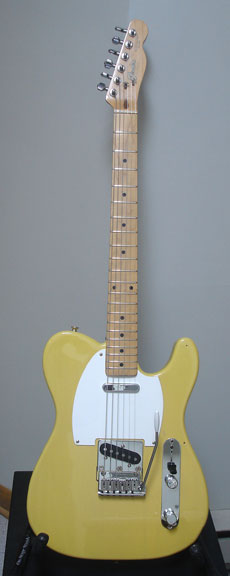 |
|
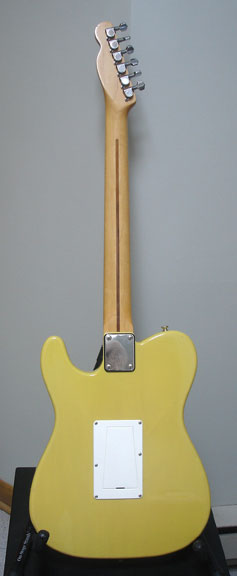 |
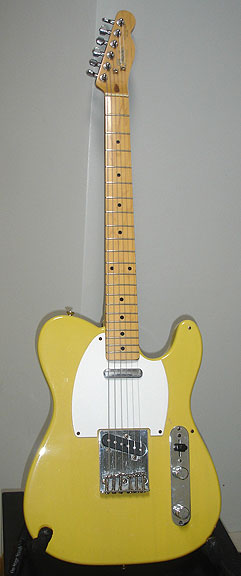 |
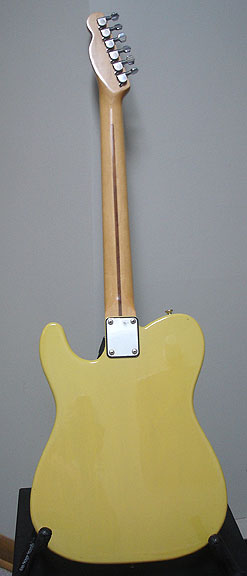 |
|
|
|
|
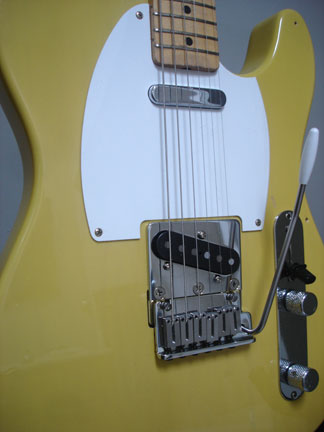 |
|
|
|
|
|
Guitar as it appeared before the modifications |
|
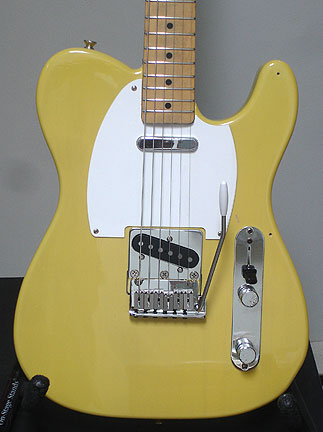 |
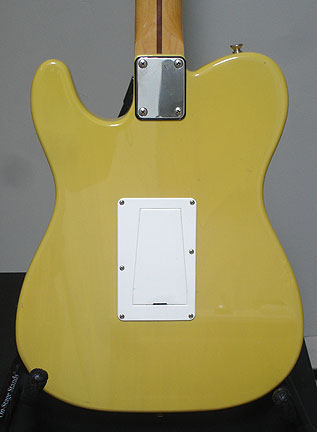 |
|
| The instrument shown here is a retro-fit of the "Missing Link" bridge/pickup system into a Fender American Standard Stratocaster®. The bridge pick-up is a Seymour Duncan vintage Broadcaster. The rest of the instrument remains stock. |
|
|
|
|
|
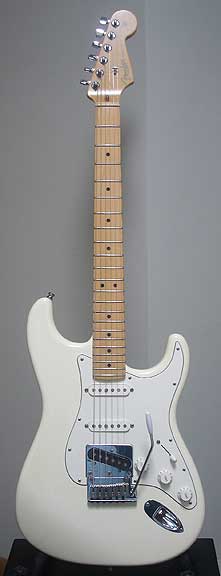 |
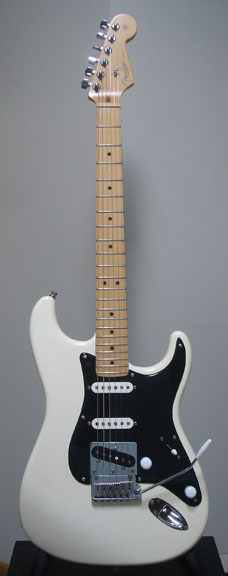 |
|
|
|
|
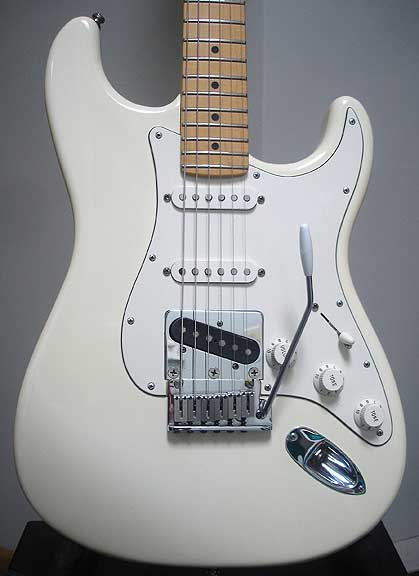 |
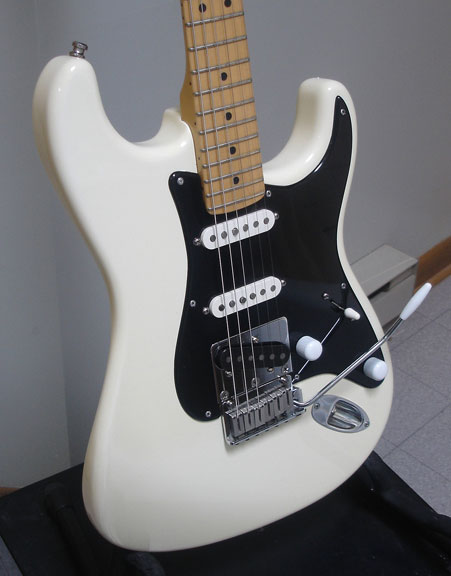 |
|
|
|
|
Same Instrument with the addition of a custom plexiglass pickguard and white knurled dome knobs |
|
|
The acoustic guitar shown here is a sample of the U.S. Guitar Kits product built and finished by me, to show what is possible as an end result when a kit is purchased. Some of the unique aspects added to my build are: the headstock shape, the addition of a fancy maple burl veneer on the headstock and neck heel, and the sunburst finish with very dark sides, neck and back.
|
|
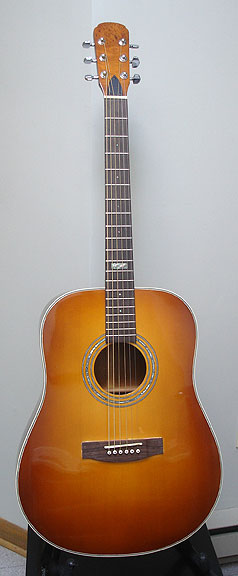 |
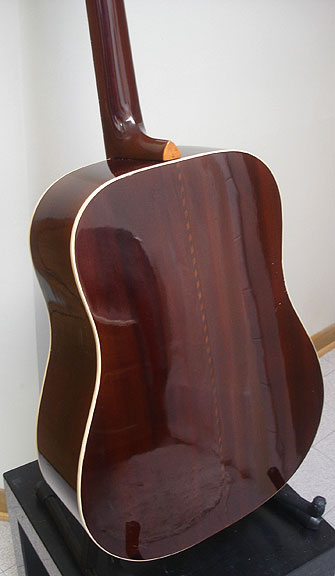 |
|
|
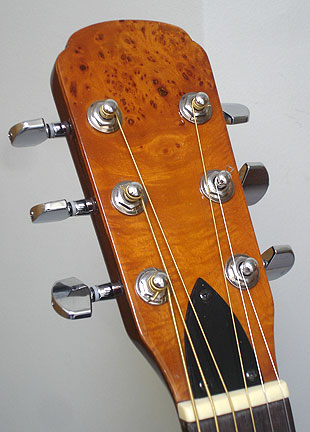 |
|
|
|
|
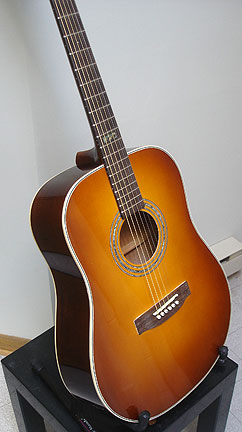 |
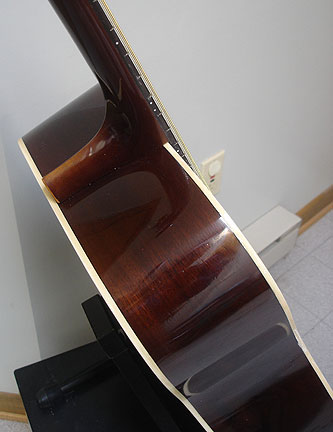 |
|
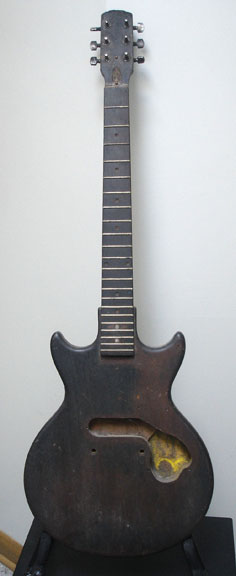 |
This is a true tale of a "Phoenix " resurrected from the ashes (literally). The guitar pictured here was brought to me in the condition that you see on the left. It had either been in a fire, or had been set fire on stage, but in any case, it was quite charred. The tip of the headstock had actually been reduced to charcoal. It turns out that it is actually a 1964 Gibson Melody Maker. (The serial # was still intact). The picture that you see on the right, is the same instrument, after the resurrection. It has been re-finished in a Gibson style cherry red nitrocellulose laquer, fitted with new pearl inlays, a custom plexiglass pickguard, DiMarzio pickups, a Badass bridge and the appropriate new electronic components with a phase switch.
|
|
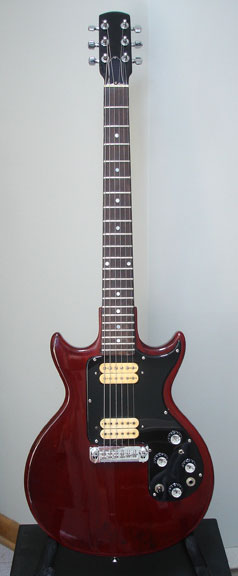 |
|
|
|
|
|
|
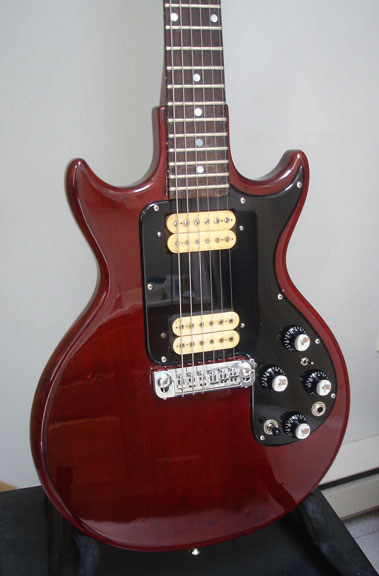 |
|
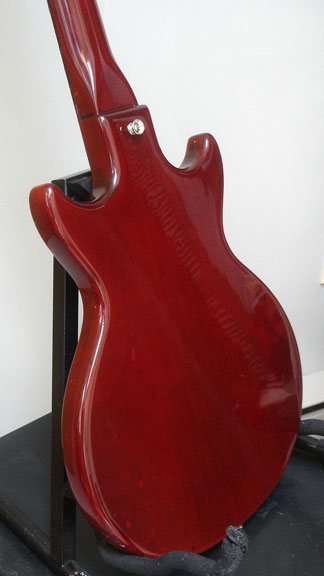 |
|
|
This is another full custom instrument built to showcase my "Missing Link" bridge/pickup system. This is the application as a Telecaster® with an all metal link to a Strat® tremolo bridge system. This guitar has an Alder body and an extra "chunky" fat maple neck finished in nitrocellulose lacquer. The guitar has a custom mirror plexiglass pickguard which carries a vintage "broadcaster"Seymour Duncan pickup. Wiring is standard Tele® . The bridge pick-up is a Duncan vintage Broadcaster pick-up. This is a very resonant instrument that produces a variety of terrific tonal qualities!
Telecaster, Strat, and Tele are registered trademarks of Fender Musical Instruments, which is in no way affiliated with Feldman Guitar Works.
|
|
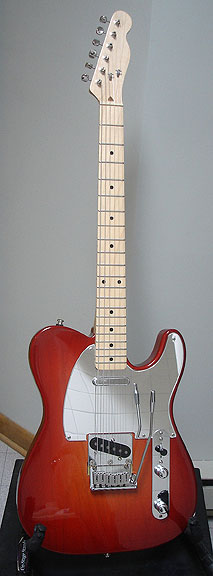 |
|
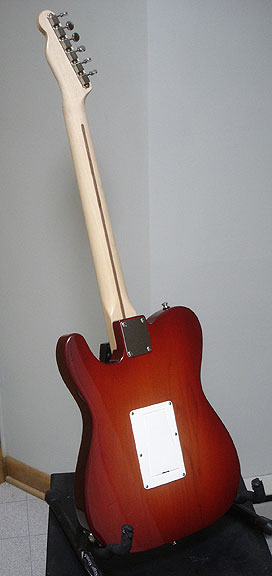 |
|
|
|
|
|
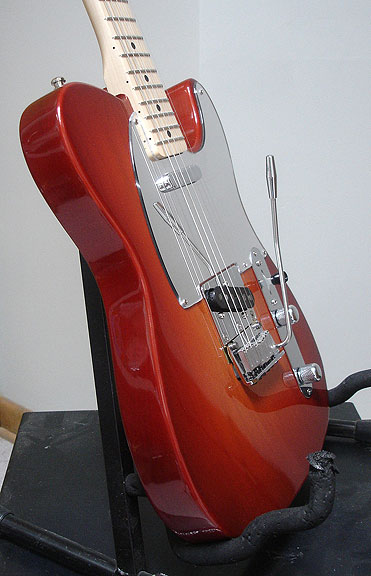 |
|
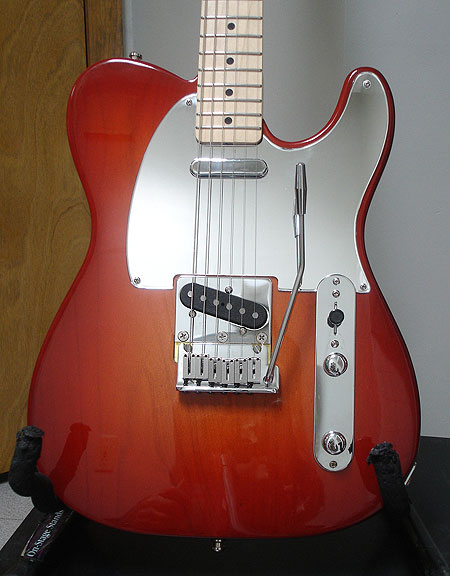 |
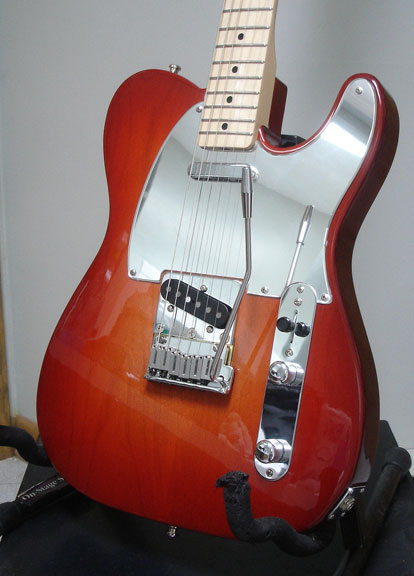 |
|
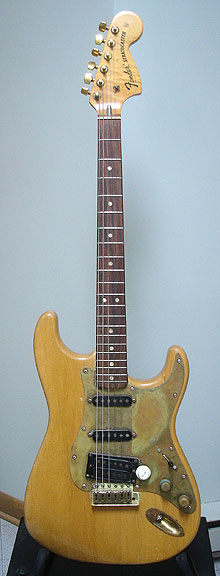 |
This instrument is a 1972 Fender Stratocaster that was submitted for a makover custom job including the retrofit of the "Missing Link" bridge and pick-up system and a unique custom pickguard which consists of a thin layer of tortoise shell material overlayed with clear plexiglass with rounded and polished edges. The effect is quite exquisite, and retains the crisp tone quality that my plexiglass pick-guards are known for. We are calling it " Tortoise shell under glass". (see close-ups below). The frets were dressed, and the rest of the body hardware replaced. The five way switch was replaced with three mini toggle switches. the tele pick-up is a two way on-off, and the two strat pick-ups each have a three way with on-off-out of phase. This set-up allows for some delicious tones and combinations that are un-available in the normal strat five-way switch set-up.
|
|
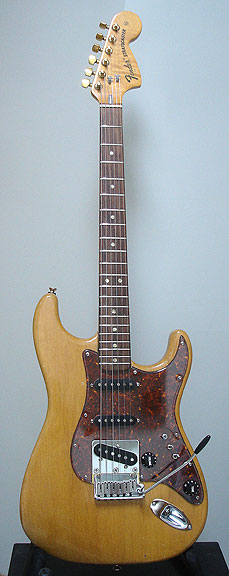 |
|
|
|
|
|
|
|
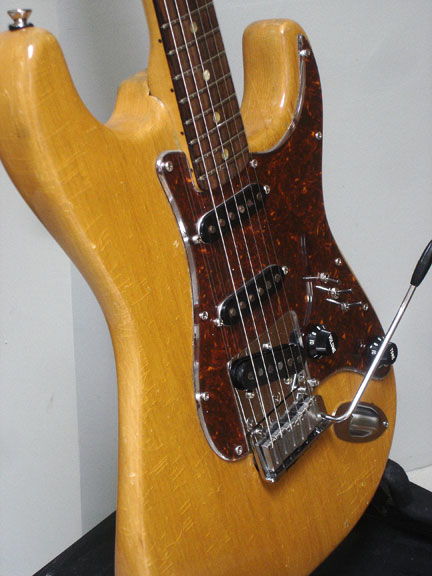 |
|
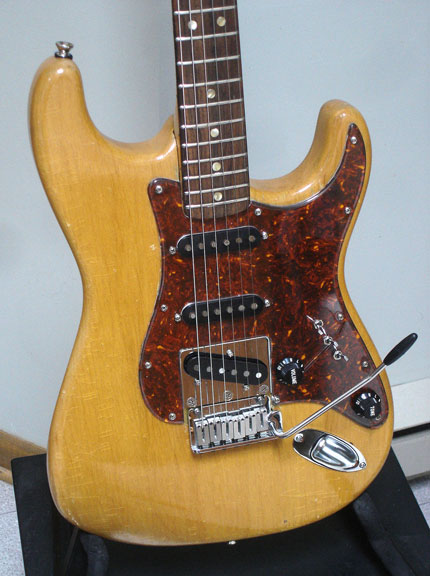 |
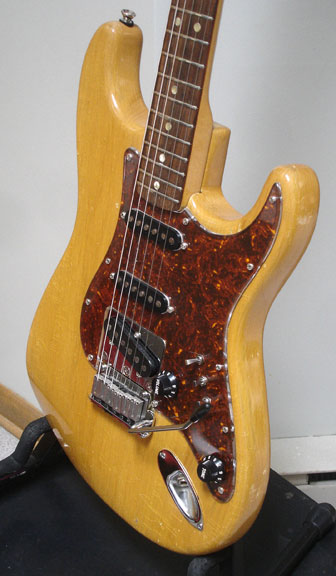 |
|
|
|
|
|
|
|
|
|
|
|
|
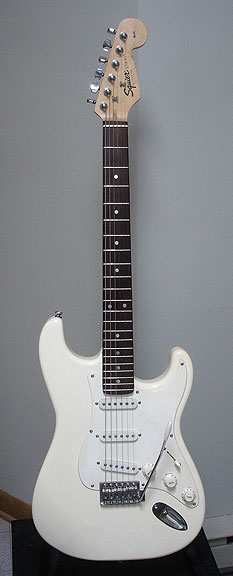 |
This is another "Missing Link" makover, this time done to a Fender Squire Strat. This guitar was purchased as an "in house" studio guitar for recording purposes. Along with the full "Missing Link" system incorporating the Fender American Standard tremolo, I installed Seymour Duncan vintage stacked pick-ups, which retain the vintage Fender pick-up sound quality, but also have a virtually noise free humbucking effect for studio use. The instrument is in use and owned by the Hickory Street Studio in Blauvelt, NY Other work done to this instrument was a fret dress, and a new bone nut for improved playability, and the Feldman Guitar Works custom black plexiglass pick-guard. This Squire became a "world class" instrument.
|
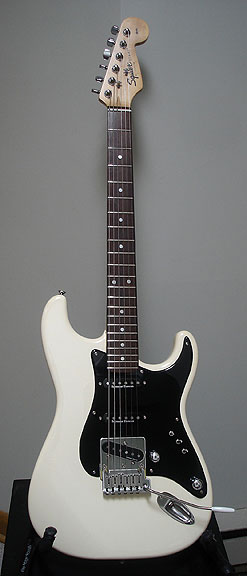 |
|
|
|
|
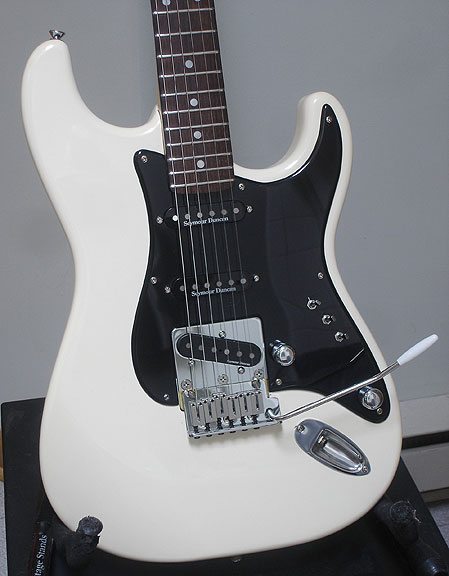 |
|
|
|
|
|
|
|
| This is a 1978 Les Paul Deluxe that came to me in the condition shown here in the near right. It was originally a Tobacco Sunburst finish and someone had "roughly chiseled" out the pick-up openings to install large humbuckers. The openings were" rough hewn" and too large for the large humbuckers. My customer wanted to convert this to a Gold Top with "soapbar" P-90's. I routed the pick-up openings to straighten them and make them precise, so that I could install some new maple into the top, and re-rout for the P-90s! This is visible in the picture on the far right. The customer also wanted the back, sides and neck finished in natural clear, so I stripped all the old finish off and applied the gold finish on the face, and clear nitrocellulose lacquer over the entire instrument. I dressed the frets, Installed Seymour Duncan stacked P-90's, all new pots, and other new bits and pieces, and set it up. It is now a beautiful Gold Top Les Paul (see below and right), and it plays great!
|
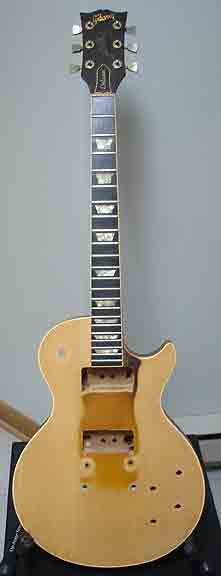 |
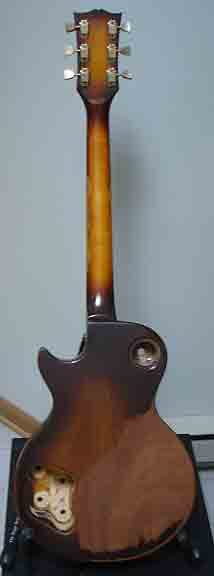 |
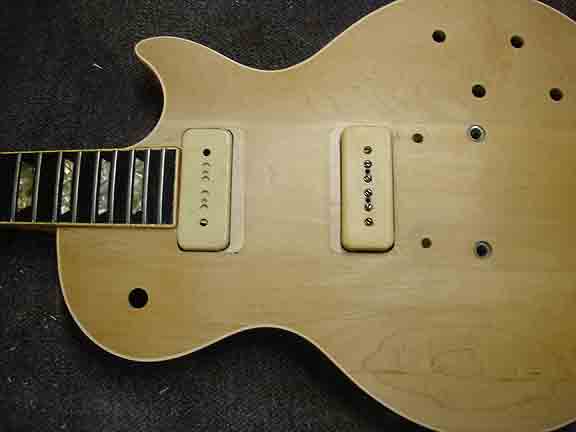 |
|
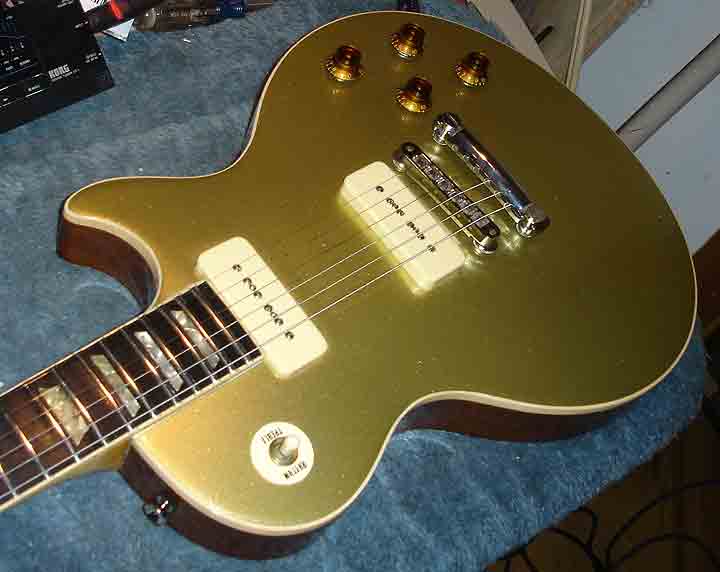 |
|
|
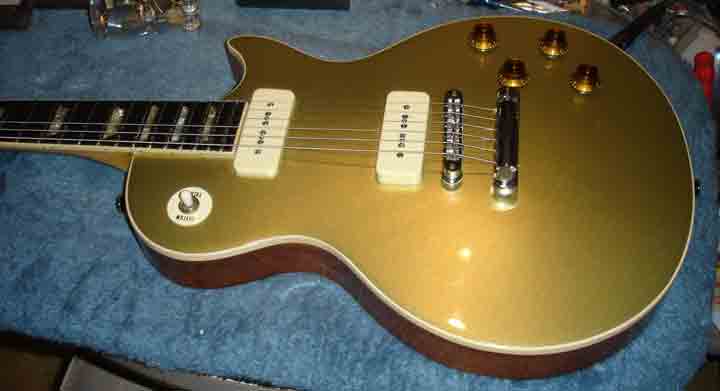 |
|
|
|
|
|
|
|
|
|
|
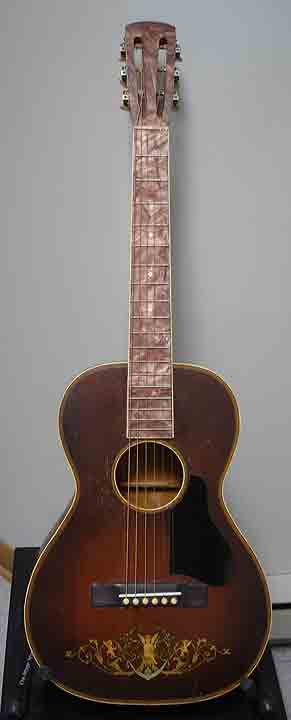 |
This instrument is a 1929 May-bel parlor guitar which was made by the Slingerland Drum company. This was a restoration project. The guitar had a crude hand-made bridge which was totally incorrect in design and function, and a green pickguard. I researched this instrument, found pictures of correct samples, and made a new bridge which is correct to the original design and materials. I adjusted the saddle placement for correct intonation, and made a bone saddle instead of the original design, which was a piece of fret-wire. The bridge is made of maple and stained black, as described in my research on these instruments. After exhaustive research in trying to find the rose colored pearly drum material to match the neck and peg-head overlay, I had to resort to making a black pickguard, as the rose colored material could not be found to fashion a pickguard as it would have been. After a fret dress and set-up, this guitar plays very nicely.
|
|
|
|
|
|
|
|
|
|
|
|
|
|
|
|
|
|
|
|
|
|
|
|
|
|
|
|
|
|
|
|
|
|
|
|
|
|
|
|
|
|
|
|
|
|
|
|
|
|






























































